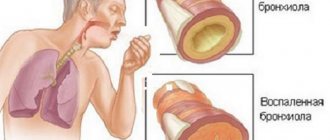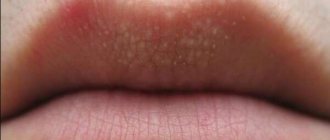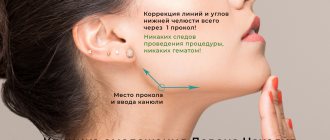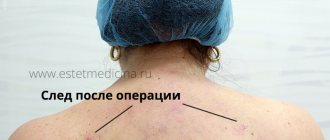What kind of frenulum occurs between the upper lip and gum of a child?
The frenulum, located between the gum (above the central front teeth) and the upper lip, is normal (0.5-0.8 cm from the edge of the jaw), low-mounted, short, and wide. These features are already noticeable at birth; in infants they make feeding difficult, and then interfere with speech and the formation of an even line of teeth.
Normal frenulum between front teeth
Normally, the frenulum between the upper front teeth begins at a distance of 5 to 8 mm from the necks of the central incisors. It should be visible when the lip is lifted, and its base is a thin fold no wider than 1 mm, elastic and stretchable.
Low
The low location of the beginning of the frenulum of the upper lip leads to the fact that when moving (eating, talking) it pulls on the interdental space. As a result:
- a gap forms between the front teeth,
- food accumulates under the lip,
- the necks of the teeth are exposed.
This leads to an external defect and inflammatory processes in the oral cavity. In the absence of correction, clarity of speech and bite formation suffer.
Wide between upper teeth
If the bridle is attached between the front teeth with a wide base, then the front incisors will have a gap (diastema) or grow crookedly.
What does a short frenulum of the lips lead to?
A short frenulum of the lips creates problems with feeding in infants; for older children it is dangerous due to improper growth of the incisors and speech difficulties; in adults it leads to inflammation, destruction and loss of teeth.
In a baby
A short upper frenulum in an infant is accompanied by difficulty sucking the breast. After 2-3 sucking movements, the baby stops eating, cries, and cannot cope with nutrition even with severe hunger. Children gain weight poorly and develop slowly.
The child has
If the frenulum defect is not noticed by the parents, then in the future the teeth grow at intervals, the anterior central incisors move forward, and a pathological bite occurs.
When the speech function develops, the pronunciation of individual sounds is impaired, and speech is slurred. Exposing the necks of the teeth causes inflammation and increased sensitivity; the child reacts painfully to sour or sweet foods.
In an adult
Due to delayed correction of the frenulum, a chronic inflammatory process appears in the oral cavity - periodontitis, gingivitis. This causes loosening and loss of teeth, and in severe forms it can affect the bone tissue of the upper jaw - osteomyelitis.
Wide between upper teeth
With a wide frenulum between the lip and the upper central teeth, it is difficult to fully clean the oral cavity. Before surgery, cleaning is carried out using cotton swabs; regular rinsing after meals is recommended. If correction is not carried out when permanent teeth appear, they grow at intervals.
Watch this video about anomalies of the frenulum of the upper lip and their symptoms, diagnosis and treatment:
Description of the procedure
Labial frenuloplasty is an operation in which the tissue of the frenulum is trimmed. The frenulum of the lip is a part of the oral cavity that looks like a fold of mucous membrane. It is necessary to ensure normal fixation of the upper lip to the jawbone area. Normally, the frenulum is woven into the gum tissue at a distance of 0.5-0.8 cm from the necks of the anterior incisors. And if the frenulum of the lip extends beyond the areas of the front incisors, and the attachment points are not visible at all, then it is considered to be greatly shortened. Usually the doctor detects this pathology immediately during a visual examination. This procedure should be performed if indicated, and only on the direction of a doctor.
More on the topic: Pediatric dentistry. Removal of a tooth.
Indications for surgery
Normally, this area of soft tissue, located under the upper lip, should be fixed at a distance of half a centimeter or 0.8 mm from the necks of the front teeth (“ones”). With a physiological location and the correct size, a child or adult does not have problems with articulation, speech, difficulties in eating, or aesthetic defects in this area of the face.
If they are noticed, it is easy to determine the “culpability” of the frenulum of the upper lip when examined by a doctor. Plastic surgery is performed when, due to its improper development, the following occurs:
- Diastema is a pronounced, unattractive-looking gap between the teeth. The problem here is not just aesthetics. The frenulum, when secured in the interdental papilla, prevents the correct position of the teeth, injures them, resulting in periodontitis. The incisors gradually move apart, simultaneously leaning forward.
- Periodontal diseases or identification of an increased likelihood of their occurrence. This is possible with a short frenulum, which lifts the gum upward, exposing the necks and roots of the teeth. The opened space is filled with food debris, which will later begin to rot.
- Obstacles in installing a prosthesis. Upper lip frenuloplasty in adults is often done for this reason. If it is too short, the prosthesis cannot be secured. The impaired mobility of the lips that exists with a short frenulum will lead to constant slipping of the replacement structure.
- Obstacles in correcting the bite. Incorrect positioning of the frenulum affects its formation, as it creates a load on the entire row of teeth. In order for the installation of braces or plates to give the desired result, it is necessary to tidy up this area of the soft tissues of the mouth.
- Inability to pronounce certain sounds, usually vowels. This is the rarest reason requiring surgery.
- Sucking dysfunction in infants. For the correctness of the process, the condition of all parts of the oral cavity is important. If, due to a problem, a child cannot get enough to eat, becomes noisy, and does not gain weight well. In this case, the intervention is carried out at an early age.
For what indications is lip frenuloplasty performed?
Adjustments are made if the following factors exist:
- Plastic surgery is often prescribed when there is a gap between the front teeth. In these situations, the wide frenulum opposes the normal convergence of the incisors towards the central region. Due to the fact that increased pressure is constantly exerted, the gap gradually becomes larger and the teeth shift in different directions. Also, when the interdental papilla is damaged, periodontitis occurs;
- recommended for use during orthodontic treatment therapy. All soft tissues of the oral cavity, as well as the frenulum of the lip, cause increased pressure on the teeth and provoke malocclusion. If orthodontic treatment is required, labial frenuloplasty is performed first;
- if there are periodontal pathologies, as well as at the risk of their occurrence. Typically, in these conditions, a short frenulum causes contraction of the mucous tissue in the area of the base of the teeth, this causes exposure of the roots;
- Lip frenuloplasty is recommended during the preparatory period before the installation of prosthetic devices. If you plan to install prostheses in the near future, then it is advisable to first correct the frenulum, because if it is shortened, it can cause the prosthetic elements to be reset;
- frenuloplasty is recommended if there are problems pronouncing words, problematic formation of sounds and other diction problems. But only a specialist can accurately determine whether the frenulum of the upper lip needs to be trimmed when examining the patient.
Optimal time for plastic surgery
It is never too late to have surgery to normalize the frenulum of the upper lip. But it is better to carry it out without waiting for serious problems, including not only difficulties with teeth and gums, articulation, but also digestive pathologies.
Plastic surgery of the frenulum of the upper lip in children is done from 5.5 years old , if there are no difficulties with breastfeeding in infancy. During this period, milk teeth are replaced by permanent teeth. And until the latter have completely erupted, it is easy to use correction to prevent the incisors from moving apart, forming a diastema. The problem will be prevented, which will be helped by the appearing “twos”.
Some experts prefer to postpone intervention until the child is 7 or 8 years old. By this time, the front incisors have already erupted, and the bite can be traced more clearly. This means that plastic surgery will be more accurate.
Causes of pathology and treatment
In the vast majority of cases, the cause of a short frenulum is congenital. Almost all boys are born with a narrowed foreskin. Physiological phimosis is often combined with a shortened frenulum. Over time (at 5-6 years) everything returns to normal. The head opens freely and painlessly. For some reason this does not happen in approximately 5% of children.
If a child has such a pathology, it is recommended to correct the foreskin and frenulum at an early age. This will help get rid of possible problems in the future.
Acquired causes of short frenulum:
- Injuries to the penis that occur during sexual intercourse. For example, hard sex with too active frictions or the process of defloration.
- Constantly wearing tight underwear and tight trousers.
- Sports injuries.
- Tattoos and piercings in intimate places, as well as self-injection of Vaseline or beads under the skin, leading to damage to the penis.
- Venereal diseases.
- Diabetes mellitus causing circulatory problems.
The pathology of the frenulum cannot be treated with conservative methods. All advice on self-extension, which can be easily found on the World Wide Web, is deception or delusion. The only effective and efficient remedy known today is frenuloplasty. This minor surgical procedure, performed under local anesthesia, lasts only 20-30 minutes.
If sexual intercourse is accompanied by unpleasant sensations in the frenulum area, you should not wait for a rupture, because it is very painful and dangerous. The right decision is to see a urologist as soon as possible.
Contraindications for surgery
Not everyone can intervene when there is a problem. There are also contraindications to plastic surgery:
- pathologies of the oral cavity,
- osteomyelitis (bone disease),
- complicated caries,
- previous radiation exposure to the head and neck area,
- serious pathologies of the nervous system,
- blood diseases,
- worsened infections that do not affect only the oral cavity,
- mental illness,
- serious metabolic disorders with a tendency to collagenosis,
- oncological pathologies.
Stages of preparation for plastic surgery
Frenumplasty is a simple intervention. But given the list of contraindications, the patient must be examined:
- take general blood and urine tests, and also do a coagulogram,
- perform fluorography.
The oral cavity must be sanitized, that is, caries and other dental problems must be cured. Immediately before the intervention, the patient needs to eat well, since food intake is prohibited for some time after it. Then you need to brush your teeth and rinse your mouth.
Types of operations on the frenulum of the upper lip
How the problem area will be corrected depends on its structure and the type of developmental disorder. There are several possibilities:
Laser plastic surgery
The most modern method, which reduces the time of surgery and subsequent rehabilitation. There is no need for stitches or worry about a lot of blood. The likelihood of getting an infection, experiencing severe pain and getting a postoperative scar with laser plastic surgery is also reduced to zero. This is especially important if the correction is performed on a child.
Laser plastic surgery is performed with local anesthesia with gel. The beam is directed to the problem area. Under its influence, excess tissue evaporates, sterilizes it and seals damaged blood vessels.
Frenuloplasty
An old and proven method of correcting its position, carried out using surgical instruments. The intervention is performed under local anesthesia, but infiltration. There are 2 methods of performing the operation. Y-shaped frenuloplasty involves creating an incision on the frenulum of the appropriate shape.
During the Limberg operation, defects on the mucosa have the outline of the letter Z. But both interventions are done in order to move the frenulum to the desired location. They are carried out after an injection of an anesthetic, and self-absorbable material - catgut - is used to apply sutures. Frenotomy is performed with a narrowed frenulum. The mucosal area is cut transversely, as a result of which it acquires a greater length. The suture is placed along the cut edge.
Frenum removal or frenectomy
The operation is performed if the frenulum is too wide. Then a lot of plaque accumulates on the teeth, and problems with them become more threatening. During the operation, an incision is made along the edge of the mucosal area, the interdental papilla and a certain portion of the tissues located near the roots of the central incisors are removed.
Short frenulum surgery
Of all the defects of the frenulum of the foreskin known to medicine, the most common is its insufficient elasticity and length. A short frenulum can be either a congenital defect or an acquired one.
Photo: before and after circumcision
The cause of deformation of this part of the male genital organ may be a previous injury. During sexual intercourse, a frenulum defect gives a man inconvenience and unpleasant sensations, since the foreskin does not move properly, leaving the head half-closed. In addition, pain may occur when excited.
Healing can also occur naturally. However, a scar forms at the site of the injury, the length of the frenulum becomes even shorter, and the frequency of premature ejaculations increases. It is the doctor, not the patient, who decides whether to suture or not.
Postoperative care
After the intervention, slight pain may be felt in the area affected by the instruments or laser. In the latter case they are less pronounced. In order not to intensify them, to allow injured tissues to heal, and to prevent infection, it is necessary:
- Don't eat for 2, 3 hours. And in the next couple of days, food should not be rough or hot. Otherwise, there is a risk of injuring healing tissues.
- Maintain oral hygiene. Use a soft brush to brush your teeth. Rinse the mouth thoroughly. It is better to have an adult brush your child's teeth.
- On one of the first postoperative days, go to the doctor for examination.
- After a week, start doing gymnastics to strengthen the chewing and facial muscles.
For some time after the intervention, some discomfort may be felt due to the changed characteristics of the movement of the lips and tongue. But this is a stage of adaptation to a new situation, lasting no longer than 4, 5 days. During this period, all damage to the mucous membrane has time to heal, and previous problems with diction disappear. It will take more time to eliminate the diastema.
Why is surgery performed - plastic surgery of the foreskin frenulum?
The frenulum of the penis is a fold of skin running from the glans to the foreskin. Sometimes, due to congenital characteristics or injury, its length is insufficient, which causes pain and tissue tears during sexual intercourse. The situation can be corrected with the help of frenulotomy - dissection of the frenulum of the penis followed by plastic surgery.
The short frenulum becomes tense during intimacy, causing pain and discomfort. Due to painful sensations, a man is unable to have sexual intercourse. If the operation is not performed on time, the patient will develop a psychological failure complex linking intimacy and pain. It will be difficult to get rid of the problem.
A tight frenulum pulls the head of the penis down during an erection. The penis becomes curved, making intimacy impossible.
The frenulum may break during intercourse. The rupture is accompanied by severe pain and bleeding. Sometimes during contact the tissues do not tear completely, but are constantly torn a little. This leads to the formation of cracks and scarring.
The frenulum is a sensitive area containing a large number of nerve endings. Therefore, its stretching during intimacy causes additional stimulation, reducing the duration of sexual intercourse. The result is premature ejaculation. This significantly reduces the sexual satisfaction of both partners and can cause psychological complexes in a man.
Therefore, in order to prevent the occurrence of psychological and medical problems, if
the frenulum of the penis
is short it is necessary to undergo
plastic surgery
. After the operation, the patient will be able to lead a full intimate life without pain and discomfort.
What is recommended after excision of the frenulum of the lower and upper lips
After surgery to excise the upper or lower frenulum, the following is prescribed:
- eating liquid or semi-liquid foods - ice cream, vegetable, fruit, meat, fish purees, pureed soups and cereals,
- restriction of speech - until healing you need to try to remain silent more,
- rinse your mouth with a solution of hydrogen peroxide, Chlorhexidine, Miramistin after each meal,
- from the 5th day, gymnastics of the facial muscles is shown - stretching the lips into a tube, stretching in a smile, prolonged pronunciation of vowel sounds.
Cost of upper lip frenuloplasty
The price for an operation in Russia can reach 1400, 6000 rubles. In Ukraine, a similar intervention will be carried out for 300, 1500 hryvnia. The cost also includes consultation and anesthesia; it also depends on the method in which the operation is performed. Laser plastic surgery will cost more. The price is higher in a prestigious clinic, but you don’t always need to go there.
Recovery
Typically, you can return home on the day of surgery.
- It is better to remain calm for the first two hours after the intervention;
- Upon returning home, you need to treat the intervention area with antiseptic agents;
- Abstinence and refusal of sex is prescribed for a period of 4-6 weeks;
- When restoring intimate contacts, at first you need to use special lubricants;
Be sure to check with your doctor about the specific hygiene measures. They may vary depending on the surgical technique.
The rehabilitation period lasts for approximately a month. Upon completion, it is recommended to visit a doctor who can evaluate the effectiveness and success of the surgical procedures performed.
Damage to the frenulum on the gum of a child
An incorrect anatomical shape of the frenulum in a child can cause inflammation and pain, injury - rupture and tearing.
Mouth hurts after eating hot food
A painful reaction in the mouth to eating hot food is possible due to inflammation of the mucous membrane. This is a consequence of a short upper frenulum. It is often injured when chewing or talking, and due to the tight fit of the lip to the teeth, the cleansing of this space is disrupted.
If surgery is not yet indicated due to age, then rinsing with a decoction of sage, chamomile or calendula is prescribed. It is prepared at the rate of a tablespoon per glass of boiling water. Leave for 30 minutes, then strain and use warm.
Inflammation under the upper lip
Inflammation of the frenulum under the upper lip occurs when irritated by hard food, tartar, part of the filling, or hot food. The provoking factor is often malocclusion and anatomical changes in the growth of the frenulum. For treatment, rinsing with a solution of hydrogen peroxide or tincture of calendula and eucalyptus (a teaspoon per glass) is recommended.
Applications of anti-inflammatory drugs are also prescribed. To do this, apply cotton strips moistened with solutions of Chlorophyllipt, Chlorhexidine, Miramistin. To speed up healing, use sea buckthorn or rosehip oil.
Tore off or was torn due to injury
If the frenulum of the upper lip has come off, or the child has ruptured it due to injury, then you should immediately apply a cotton pad moistened with hydrogen peroxide. It can also be treated with Miramistin spray.
On this day, food should be cool in temperature and have the consistency of puree. If there are no contraindications, then ice cream is recommended. Usually such injuries heal quickly. If the bleeding does not stop for a long time, a dental examination is necessary.
To speed up the restoration of the integrity of the mucous membrane, use Solcoseryl dental paste after treating the wound with Chlorhexidine and spray Tantum Verde aerosol.
Process on the frenulum
The appearance of a process on the frenulum of the upper lip can be due to a viral infection - papillomatosis, trauma, accelerated cell division (tumor nature). The size of the neoplasm is from 0.2 to 2 cm. The color matches the color of the mucous membranes or is lighter. A dental examination is required to make a diagnosis.
Treatment is surgical - the papilloma is cut off and sent for examination. If a viral origin is confirmed, the immunomodulator Groprinosin is prescribed.
Treatment of pathologies of the frenulum on the gums of a child
If the frenulum is short, wide or low, surgical correction is performed - excision, trimming, plastic surgery. All interventions are performed under anesthesia; in normal cases, local anesthesia is sufficient.
We recommend reading about cleft lip surgery. From the article you will learn about the causes of the development of pathology, symptoms and types of pathology, options for surgical correction of the defect.
And here is more information about the correction of rhinolalia from a speech therapist and surgeon.
Parents should know that not all cases require surgery. But if the doctor talks about obvious indications for her, you should not refuse plastic surgery or put it on the back burner out of pity for the baby. The consequences of this may be worse than short-term, minor pain and fear during the intervention.
General information
At the beginning of therapy, as a rule, less invasive methods are used.
Thus, actions aimed at stretching the frenulum tissue can be recommended. Then, depending on the situation, correction can be made by placing a suture on the frenulum. The tightly tied frenulum gradually separates into two parts, the tension disappears and no further intervention is required. Sometimes this procedure is performed using a laser.
However, these methods are not always sufficient. Then corrective surgery is necessary. It can be plastic surgery - cutting the frenulum and suturing an additional skin flap, or completely removing the frenulum. The choice of the appropriate option is made in dialogue with the doctor.
Preparation for surgery includes undergoing a standard set of tests and examinations. The doctor will tell you more about them and give you a referral.
The intervention itself can be performed under either local or general anesthesia. In case of general anesthesia, you should refrain from eating 10-12 hours before surgery and drinking water for 4 hours.










